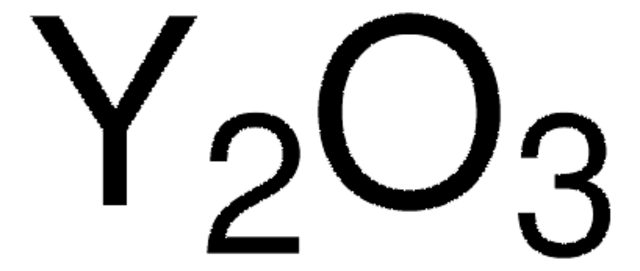450812
Copper(II) oxide
powder, 99.99% trace metals basis
Synonym(s):
Cupric oxide
Sign Into View Organizational & Contract Pricing
All Photos(1)
About This Item
Empirical Formula (Hill Notation):
CuO
CAS Number:
Molecular Weight:
79.55
EC Number:
MDL number:
UNSPSC Code:
12352303
PubChem Substance ID:
NACRES:
NA.23
Recommended Products
Quality Level
Assay
99.99% trace metals basis
form
powder
application(s)
battery manufacturing
SMILES string
[Cu]=O
InChI
1S/Cu.O
InChI key
QPLDLSVMHZLSFG-UHFFFAOYSA-N
Looking for similar products? Visit Product Comparison Guide
General description
Copper(II)oxide or cupric oxide (CuO) is a chemically stable black solid. As a mineral, it is called tenorite and is a critical product of copper mining. Our CuO with a trace metals purity of 99.99% is a high purity material ideal for applications in electronics, ceramics, and catalysis. CuO is a medium bandgap semiconductor with a bandgap in the range of 1.2-2.6 eV depending on the preparation conditions and usually shows p-type conductivity due to the presence of copper vacancy defects. In ceramic sciences, CuO is a key componentof many types of high Tc superconducting materials like BaYCu3O9-δ and Bi2Sr2CuO6+δ; the CuO is usually milled or mixed with other metal oxides and sintered at high temperatures to obtain complex metal oxides. In the field of catalysis, CuO is also widely used as a precursor to synthesize electrocatalysts for organic synthesis and degradation of organic pollutants.
Application
- Copper(II) Oxide Nanoparticles Embedded within a PEDOT Matrix for Hydrogen Peroxide Electrochemical Sensing.: This study explores the use of copper(II) oxide nanoparticles embedded in a PEDOT matrix for effective hydrogen peroxide electrochemical sensing, highlighting the material′s potential in energy storage applications (Lete et al., 2022).
- Green Fabrication of Nonenzymatic Glucose Sensor Using Multi-Walled Carbon Nanotubes Decorated with Copper (II) Oxide Nanoparticles for Tear Fluid Analysis.: Researchers developed a nonenzymatic glucose sensor using copper(II) oxide nanoparticles on multi-walled carbon nanotubes, showcasing copper oxide′s versatility in high-capacity energy storage solutions and renewable energy applications (Asgari Kheirabadi et al., 2022).
- Facile Synthesis of Copper(II) Oxide Nanospheres Covered on Functionalized Multiwalled Carbon Nanotubes Modified Electrode as Rapid Electrochemical Sensing Platform for Super-Sensitive Detection of Antibiotic.: This paper discusses the synthesis of copper(II) oxide nanospheres on multiwalled carbon nanotubes, emphasizing their application in rapid and sensitive electrochemical sensing, relevant to battery technology (Chen et al., 2019).
- Composite Planar Electrode for Sensing Electrochemical Oxygen Demand.: This study focuses on the development of a composite planar electrode incorporating copper(II) oxide for sensing electrochemical oxygen demand, relevant to improving battery efficiency (Orozco et al., 2008).
Signal Word
Warning
Hazard Statements
Precautionary Statements
Hazard Classifications
Aquatic Acute 1 - Aquatic Chronic 1
Storage Class Code
13 - Non Combustible Solids
WGK
WGK 3
Flash Point(F)
Not applicable
Flash Point(C)
Not applicable
Personal Protective Equipment
dust mask type N95 (US), Eyeshields, Gloves
Choose from one of the most recent versions:
Already Own This Product?
Find documentation for the products that you have recently purchased in the Document Library.
Sumanta Kumar Meher et al.
Nanoscale, 5(5), 2089-2099 (2013-02-06)
In the quest to enhance the selectivity and sensitivity of novel structured metal oxides for electrochemical non-enzymatic sensing of glucose, we report here a green synthesis of unique sandwich-structured CuO on a large scale under microwave mediated homogeneous precipitation conditions.
Chengyi Hou et al.
Nanoscale, 5(3), 1227-1232 (2013-01-11)
We report a Cu(2)O nanocrystal-reduced graphene oxide hybrid that is dispersible in water and has anticancer activity under both visible and near-infrared light irradiation. In contrast to the highly efficient killing of both normal and cancer cells initiated by the
Pierre-Emmanuel Buffet et al.
Environmental science & technology, 47(3), 1620-1628 (2012-12-18)
The fate and effects of CuO nanoparticles (CuO NPs) were examined in endobenthic species (Scrobicularia plana , Hediste diversicolor), under environmentally realistic conditions in outdoor mesocosms (exposure to Cu at 10 μg L(-1) in particulate (CuO NPs) or soluble salt
Yunxin Liu et al.
Chemistry (Weinheim an der Bergstrasse, Germany), 19(13), 4319-4326 (2013-03-01)
How to extend ultraviolet photocatalysts to the visible-light region is a key challenge for solar-driven photocatalysis. Herein, we show that ultraviolet ZnO photocatalysts can present high visible-light photocatalytic activity when combined with CuO quantum dots (QDs; <3 nm). Theoretical analysis demonstrates
Qiao bao Zhang et al.
Nanotechnology, 24(6), 065602-065602 (2013-01-24)
Reversible superhydrophobic and superhydrophilic surfaces based on porous substrates covered with CuO nanowires are developed in this study. A facile thermal oxidation method is used to synthesize non-flaking bicrystalline CuO nanowires on porous copper substrates in static air. The effects
Articles
An article concerning self-propagating reactions induced by mechanical alloying, presented by Sigma-Aldrich.com.
Our team of scientists has experience in all areas of research including Life Science, Material Science, Chemical Synthesis, Chromatography, Analytical and many others.
Contact Technical Service





